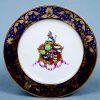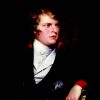The original list of the Street Naming Committee bearing the fifty-six streets and six squares of the city of Adelaide (and there must have surely been one) was somehow lost, probably in the fire of January 1839 that destroyed both Colonel William Light and Resident Commissioner James Hurtle Fisher’s adjoining houses on North Terrace. Or perhaps the fire of 23 January 1841 can be blamed, in that ‘all the records and documents connected with the legislative and executive departments of government were destroyed by the late untoward burning of the old Government Hut’. This left subsequent Adelaide City Council officials and local historians with a conundrum which has confused them ever since: some street names are still not properly attributed and Tynte Street seems to be the most perplexing.
Only the Tynte name was recorded; hardly sufficient information for historians and analysts ever since to grapple with successfully. There are few, if any references to the name of Tynte in any of the documents in the British National Archives which are pertinent to the South Australian narrative. In the storyline which followed the formation of the National Colonization Society, after Edward Gibbon Wakefield’s release from Newgate Prison, there seems to be no pointed references to the name of Tynte. That is not to say there weren’t any.
Several years of discussion with other South Australian historians have continued to obfuscate. Fortunately, there were not many Tyntes in Britain at the time and a search of county newspapers of the day almost always point to the one family, the Kemeys Tyntes of Cefn Mably, east of Cardiff, and their principal estate at Halswell House in Somerset. This was an aristocratic family stretching back to the fifteenth century, especially on the Kemeys side of the dynasty. The Tynte line from Somerset was well ensconced at Halswell House during the seventeenth century, and when the Kemeys line died out with the passing of Sir Charles Kemeys, the 4th Baronet of Cefn Mably in 1735, the Welsh property passed to his widowed sister, Jane, who had married the Reverend Sir John Tynte, 2nd Baronet of Halswell.
At the point of colonisation in South Australia there were two Tyntes who featured frequently and prominently in the British press of the day. They were father and son. The question therefore arises: was it Colonel Charles Kemeys Kemeys Tynte MP, the father, or his son, Charles John Kemeys Tynte MP who is honoured in North Adelaide? It is almost certainly one of them, but which one? Given their accomplishments in life both were worthy nominees. As to which it might be depends somewhat on the generational differences in and among the members of the Street Naming Committee. Then, of course, both may have been gathered together in the minds of those making the decision.
This question has been reviewed many times during the last two centuries and always without a satisfying conclusion. Each time any of the claims were examined the issue became more clouded.
In the late-nineteenth century the Town Clerk of Adelaide, Thomas Worsnop, and the Government Surveyor of the day, Charles Hope Harris, declared that the street was named after a Colonel Tynte of Wales who, he said, was a friend of the Surveyor General, Colonel Light. Light served under Wellington in the Peninsular War and the implication was that the two men had somehow known each other while in military service. Historian David Elder thought this to be rather doubtful, but it must be said that Light did have a connection with Colonel Tynte Snr’s home county of Somerset, for on 20 August 1818 he joined the 13th Somerset Regiment of Foot.
As Colonel Tynte Snr was so well known in that county at the time, it may be possible that the pair met. In turn, Tynte Snr was Colonel of the West Somerset Yeomanry Cavalry, so they were both senior military officers in Somerset at the same time. There is also the suggestion that Light’s regiment was attached to a military lodge, which evokes the additional possibility of a freemasonry connection. This is especially pertinent, given that Colonel C.K. Kemeys Tynte was the Provincial Grand Master of the United Grand Lodge of England in County Somerset at that time.
What makes it difficult to proceed is that by the middle of the nineteenth century both father and son were colonels. However, it is most unlikely that the younger man was a colonel until well after the Street Naming Committee had taken its decision in 1837. Charles Kemeys Kemeys Tynte, the father, was promoted to Lieutenant Colonel of the West Somerset Yoemanry Cavalry in 1803, to Sheriff of Somerset in 1808, Provincial Grand Master of the Somerset Lodge in 1820 and Colonel of the Cavalry Regiment in 1835. His son Charles John Kemeys Tynte was first promoted to Captain of the Somerset Yoemanry Cavalry in December 1823. However, when Charles Tynte Jnr’s first wife, Elizabeth (nee Swinnerton), died he took a second wife, Vincentia Brabazon, in 1841 and marital records reveal that he was not a Colonel at that point. Nevertheless, by mid-century he was a Colonel in the Royal Glamorgan Light Infantry Regiment.
It is this confusion which gave both Thomas Worsnop and Harris so much trouble in the 1880s. They both undertook research into Adelaide’s nomenclature in the lead up to the South Australian jubilee in 1886–87. If they had evidence from the 1830s, then the street must surely be named after Colonel Tynte Snr. However, if they knew it to be the younger Tynte, then he too was a colonel by the time they were conducting the research. Indeed he was still living in 1882.
Furthermore, the Harris–Worsnop attribution is for a Colonel Tynte of Wales, not Somerset, and by the time the research was conducted, Colonel Tynte Jnr was more identified with the Tynte estates in Wales than those in Somerset.
Colonel Tynte Jnr died on 16 September 1882. The assertion about the friendship between Colonel Light and a Colonel Tynte became the folklore of the Corporation of the City of Adelaide, and it was written into the council yearbooks for more than fifty years. Elder claimed that this was an error perpetuated ad nauseam. He preferred to trust the only extant primary source of the day which refers to the name Tynte. However, perhaps Harris and Worsnop were correct. Contrary views have been canvassed ever since.
It is highly probable that both Tyntes were known to the majority of the Street Naming Committee, especially given their more radical disposition in the parliament. Colonel Tynte Snr was nominally a Whig who voted in favour of the Reform Bill, but unlike George Grote and his followers he could not bring himself to support three-year parliaments or the secret ballot. He was extremely close to royalty and could count on the ear of the Duke of Sussex, especially as the Duke was the Grand Master of the United Lodge of all England and the most senior officer of freemasonry in the land.
Colonel Tynte Jnr, on the other hand, was radical enough to be considered a member of the Philosophical Radicals led by Grote in the House of Commons. He was equally, if not more of a progressive liberal than his father.
The remainder of the Street Naming Committee might not have been at all resistant to the name Tynte because whether it was the father or the son they were both on the more radical side of politics and like-minded on many of the issues held so dear by most of the Committee.
The lineage and family linkages of the Kemeys Tynte name are especially complicated, largely because the bloodline effectively died out with the death of Sir Charles Kemeys Tynte in 1785 (great uncle to Charles Kemeys), when he died without issue. At the request of Sir Charles Kemeys Tynte, his sister Jane’s daughter, Jane Jnr, and her husband were to take the name of Kemeys Tynte under Royal Licence when he died. This explains why the couple’s first son born after the name change was called Charles Kemeys Kemeys Tynte, later to become a colonel and presumably the most likely person after whom the street in North Adelaide is named.
Colonel Charles Kemeys Kemeys Tynte was born to privilege on 29 May 1778 to the name of Charles Johnson, for this was before the passing of his great uncle described above, Sir Charles Kemeys Tynte in 1785. He was the only son of Colonel John Johnson and Jane Hassel. His formative education was undertaken at Eton College, and after matriculating he took up residence in St John’s College, Cambridge in 1795.
On 25 April 1798 Charles married Anne Leyson, the daughter of the Reverend Thomas Leyson of Masseleg, in Monmouthshire. Anne had been widowed after the death of her first husband, Thomas Lewis of St Pierre, Monmouthshire, leaving her with one son and four daughters. Having assumed the name of Kemeys Tynte, Charles and Anne’s first son, Charles John Kemeys Tynte, was born in 1800, the only other person who might be considered as having the street name in North Adelaide attributed to him.
Charles Kemeys Kemeys Tynte became ‘the residuary legatee of his father’s estate, which was sworn under £10,000 in June 1806’. At the tender age of 20 his family influence and power opened a door to politics, and in 1820 he was invited to contest the seat of Bridgwater in Somerset, without expense. He was returned unopposed and continued to be invited in the same manner at subsequent elections. His son Charles John Kemeys Tynte was extended the same patronage when he sat for the seat of West Somerset (between 1832 and 1837).
Halswell House became his preferred country estate, leaving Cefn Mably to fall into a minor state of disrepair. His own son was later to take this pile for his home when he married a second time, following the death of his first wife Elizabeth.
There is some evidence that Colonel Charles Kemeys Kemeys Tynte, the subject of this chapter, saw his role in parliament as secondary to his family and other interests, for there are several references to his rather perfunctory attendance in the House. This was not unusual for many members, for unlike today where politics is seen as a vocation, in those days it was seen as an entitlement of the nobility and the privileged wealthy in society. More than once he sought special leave, sometimes pleading ill health and at other times the need to attend to urgent private business. Nevertheless, he took an independent stance on many issues and Prime Minister Wellington was not entirely sure of his allegiances.
Tynte was in support of an inquiry into the Peterloo Massacre, one of the more violent expressions of unrest in Britain at the time, and supported a petition for the relief of agricultural distress in the counties. Like most of the more strident liberals, he was totally in favour of the abolition of sinecures and the reduction of government pensions.
As a supporter of Catholic relief, Kemeys Kemeys Tynte’s opponents peppered his electorate with handbills condemning him for such an outrage, and true to his word he voted for Catholic emancipation. He was against house and window taxes, and sought to abolish the death penalty for forgery. When the Lords tried to delay the passage of the Reform Bill, Kemeys Kemeys Tynte voted emphatically against General Isaac Gascoyne’s wrecking amendment. He called for the abolition of slavery, and perhaps unsurprisingly and very deservedly his name was advanced as one of those likely to be a beneficiary in the mass creation of peers proposed to balance the numbers in the Lords with the inevitable increase in the Commons.
In 1845 the House of Lords Committee of Privileges finally declared him to be senior co-heir to the barony of Wharton. This privilege passed to his son on his death, but it was not until 1916 that his great-grandson was summoned to the Lords as the 8th Baron.
The most significant point about Charles Kemeys Kemeys Tynte, the father, is his ultimate rise to become the second-highest freemason in the land as Provincial Grand Master of the United Lodge of England for the County of Somerset. There was only one man more senior in all of England and Ireland, namely the Prince Regent, the Duke of Sussex. The two were extremely close. There are many references to meetings in Somerset, Devon and elsewhere which reveal that the Prince often presided at meetings where Colonel Charles Kemeys Kemeys Tynte was usually at his side.
What followed may hold the key to any secret left untold about Tynte Street in North Adelaide. On Friday 27 March 1846, Colonel Charles Kemeys Kemeys Tynte MP was unanimously elected Grand Master of the Ancient and Honourable Order of Masonic Knights Templar in succession to his late Royal Highness, the Duke of Sussex. Colonel Tynte Snr died on 22 November 1860.
Charles John Kemeys Tynte MP, the son, was born at Halswell House, near Goathurst, Somerset in the year 1800. This puts him in the same age bracket as most of the younger and more influential members of the Street Naming Committee. He was the only son and heir to Charles Kemeys Kemeys Tynte and followed his father into parliament in the seat of West Somerset, which he held through the halcyon days of the Philosophical Radicals between 1832 and 1837.
Described as a liberal rather than a Whig, this definition places him firmly among those named in Adelaide who are described as liberal radicals. Born to a life of privilege, Charles John was educated like his father at Eton and was heir to three estates: Halswell House, in Bridgwater; Cefn Mably, in Glamorganshire; and Burleigh Hall, Loughborough, in Leicestershire.
He first married Elizabeth Swinnerton, the third daughter and co-heir of Thomas Swinnerton Esq of Butterton Hall, Staffordshire, on 18 July 1820. Their first surviving child after Elizabeth suffered a miscarriage in April 1821 was to be their son and heir, also Charles Kemeys Kemeys Tynte, like his grandfather. He was born at Shaftesbury on 16 March 1822.
This son stayed with family tradition and went on in life to become Captain in the Grenadier Guards, Honorary Colonel of the 3rd Battalion of Prince Albert’s Somersetshire Light Infantry, and Provincial Grand Master of Monmouthshire. On 15 April 1841 Charles John Kemeys Tynte MP remarried, taking Vincentia Brabazon, the daughter of Wallop Brabazon of Rath House, County Louth, as his wife. By this marriage Colonel Tynte Jnr had a further eight children.
By 1845 Charles John Kemeys Tynte, with a new growing family, decided to move into the Tynte family estate in Glamorgan, which had been in the family since 1150 AD and was in need of renovation. This pile overlooks the Bristol Channel and the Somerset coast. It is a substantial building, incorporating a large T-shaped hall, a dancing gallery, a priest’s room and a long, stone gallery connecting to the chapel. Great rejoicing ensued in Monmouthshire when this estate was rejuvenated and renovated for Charles and his second bride.
Perhaps the most surprising thing about Charles John Kemeys Tynte is that after becoming a liberal member of parliament for the constituency of West Somerset in 1832 he was not long afterwards admitted as a Fellow of The Royal Society (on 18 December 1834). Enquiries made of the Society suggest that his elevation was not for any noteworthy accomplishment in science or the arts, but rather as patronage from the Duke of Sussex. It is acknowledged that some young men of status during the period were inducted as fellows on that basis. Tynte was presumably drawn into the Society on the recommendation of the Duke of Sussex, who was both well known to his father and President of The Royal Society, a position the Duke enjoyed for nine years. There is little doubt that this honour was somehow related to the role that both Tyntes, father and son, played in the United Grand Lodge Of England. Both Tyntes were senior members of the United Grand Lodge of England throughout their adult lives.
Charles John Kemeys Tynte was commissioned in the army and was a sometime officer of the 11th (Prince Albert’s Own) Hussars, and a Colonel in the Royal Glamorgan Light Infantry Militia. He was made Sheriff of Monmouthshire in 1829, Colonel of Royal Glamorgan Light Infantry in the 1840s, and honoured with a presentation of wine coolers and a silver plate at a dinner on Taunton in 1839.
His parliamentary career stretched over two periods; firstly as the member for West Somerset between 1832 and 1837 and then as the member for Bridgwater after his father relinquished that seat. He held this constituency from 29 July 1847 until 11 July 1865. He was variously a magistrate for Somersetshire, Glamorganshire, and Monmouthshire, leading to the elevation that saw him a Deputy Lieutenant for Glamorganshire and Somersetshire. With such large and diverse estates he was also a patron of six ‘livings’ in the Anglican Church.
Following the agitation to create fifty new peers to rebalance the House of Lords in the run up to the passage of the Reform Bill (or at some point, probably 1845) he became senior co-heir to the Barony of Wharton and co-heir also to Barony of Grey de Wilton as well as representative of the ancient families of Halswell, Kemeys and Tynte. In his twilight years Colonel Tynte Jnr retired to his residence known as Balnafeith in Old Torwood Road, Tormoham, Devon. He died on 16 September 1882.
Turning to the last word on this attribution, the link with freemasonry may also have more to do with this story than has been suggested and leads me to the conclusion that the street is named after Colonel Charles Kemeys Kemeys Tynte MP or perhaps less convincingly after the Tynte family generally. The proximity of the passage of the South Australia Act (August 1834); the formation of the first South Australian and Northern Territory Lodge under Warrant (22 October 1834); and Colonel Kemeys Tynte Jnr’s admission to the halls of The Royal Society (24 December 1834) under the patronage of the Duke of Sussex all seem to be more than coincidental, suggesting that further research is likely warranted.







Comments